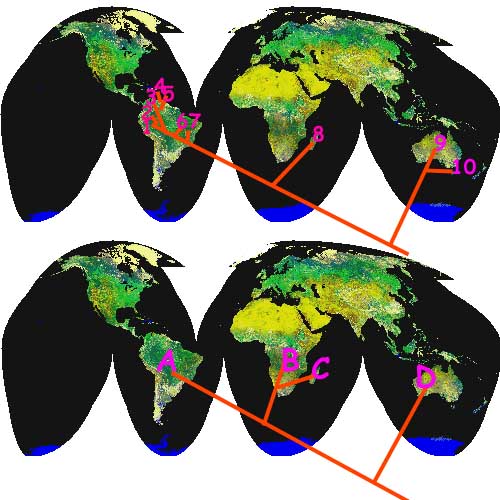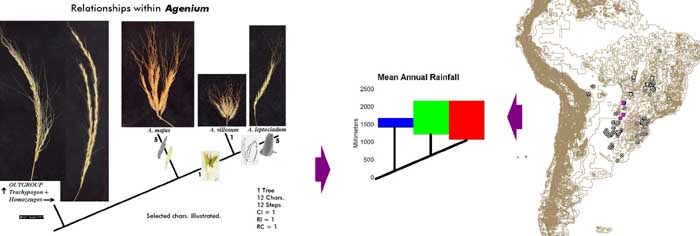The Relationship of Biogeography to Phylogeny
G.F. Guala
First Some History
Over the past two centuries Biogeography has evolved along with
other sciences from the descriptive age into the age of hypothesis testing.
Many hypotheses have been proposed and used over theyears.
They represent some of the "rules" that biogeographers have traditionally
and somewhat niavely followed over the years.
The "Centers of Origin" question that
was once central in Biogeography.
Now that we know that habitats move (habitat plates), the center of
origin for any group is a moving target and cannot really provide the kind
of spatial predictive answers that were once thought possible.
A widely used example
Hennig's Progression Rule
(Primitive forms at the base of the tree and the center of origin)
An early fully integrated (and flawed) system
Croizat's Panbiogeography
Tracks, Generalized Tracks and ancient connections (often Land Bridges).
Time scale issues and assumptions of non-existent, static (only endemics),
or linear evolution and static continents.
Lack of long distance dispersal
Vicariance Biogeography
Nelson & Platnick (also Wiley and Rosen)
-
The cladogram shows relative times of divergence of different clades.
-
We have an assumption of vicariant (or mimic vicariant) speciation.
-
Thus, the biogeographic pattern of radiation should follow the cladistic
pattern and be mappable to vicariant plates.
Strengths:
-
Predictive and testable in some instances.
-
It often actually works, especially for very old groups.
-
Its success helped convince the world of plate tectonics and their effect
on evolution.
-
It has contributed a rigorous paradigm for analyses.
Problems:
-
You need an independant hypothesis of geographic movements.
-
Rarely testable.
-
Generally there is no null, if the pattern doesn't fit, you assume dispersal,
if it does you assume vicariance.
-
Dispersal and extinction are major confounding forces.
-
Widespread and overlapping species distributions are very difficult to
interpret.
-
"areas" are difficult to define and prone to circularity.

An obligate equitorial group. Because, South America remained
connected to Australia through Antarctica later than it did to Africa one
might hypothesize a different area cladogram, but we are concerned with
a latitude limited group here so the austral connection was non-functional
as a corridor. The dispersal and climatic needs of the study organism
must be considered even in the independant cladogram used to test the area
cladogram.
The time scale issue.
If a vicariant event occurred for one species, then it is likely that
the entire community present at the time was effected. Thus, one
should see a biogeographic pattern across multiple taxa.
Exactly which taxa should we see it in (community assemblages)?
What if no speciation happened? What if we have extinction?
With the foundation of Vicariance Biogeography technique as well
as the extraordinarily useful and simple optimization algorithms available
now, we can apply all of the data to the cladogram and really, for the
first time, rigorously explore the relationships of habitats, traits
and areas to taxa.
If Vicariance Biogeography explores the relation of taxa to areas, Historical
Biogeography and Historical Ecology explore the relationships of taxa to
everything (including areas).
You can hang anything on a cladogram.
Because a cladogram is a representation of relative relationships and
not a complete phylogeny, it can be used as a framework on which to test
hypotheses of evolutionary directionality or series.
For example, Consider the following two hypotheses derived independently
of phylogenetic analyses:
1. The C4 Carbon fixation pathway is much more complex and efficient
and therefore must have evolved from the C3 pathway.
2. The C4 Carbon fixation pathway is a very complex (and therefore unlikely)
evolutionary shift and must have therefore evolved only once.
Using a cladogram generated by the Grass Phylogeny Working Group
(1998) we can test these hypotheses.

We can see that the first hypothesis is supported and the second is
rejected.
Historical Biogeography
We can test biogeographic hypotheses in the same way.

A simple archipelago example.

A climate example.





